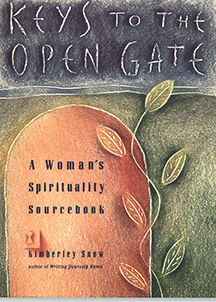The contemporary women's spirituality movement was born in the early 1970s, then expanded during the next two decades. This golden age of the women's sprituality movement produced many classic books on the subject. Keys to the Open Gate: A Woman's Spiriituality Sourcebook,first published in 1994, presented an overview of the books available at this time, plus excerpts, interviews, and lengthy bibliographies which focused on different aspects of women's spirituality.
Since that time women have made enormous progress in the political, economic and personal spheres. Yet, despite many important advances elsewhere, the issues explored in this book remain as pertinent as ever. It is my fervent hope that the women's spirituality movement will again flourish and help to ground and balance the feminine powers now arising in so many different ways.
As Hallie Iglehart Austen put it so well:
The womanspirit movement is a necessity, not a luxury. Without it, we are operating with only half our potential tools and power. What we think we want is based on what we think is possible; one of womanspirit’s most important functions is to create and implement a feminist vision. We need tools such as meditation, personal mythology, natural healing, dreamwork, study of matriarchal history and mythology, and ritual to reach beyond the possibility laid out for us by the patriarchy. We cannot wait until after the revolution for the new order to rise up, phoenix-like, out of the ashes of the old. We need to lay the groundwork now through lifetimes of hard work in researching, experimenting with, and practicing a new integration of “politics” and “spirituality.” We need new ways of healing, self-knowledge, self-power, new ways of being and relating to ourselves, one another, the Earth, and the cosmos. If we neglect them, we will create only a new version of the overly competitive, dualistic, rational, technological patriarchy.
Ultimately the goals of spirituality and of revolutionary politics are the same: to create a world in which love, equality, freedom, and fulfillment of individual and collective potential is possible. If we unite the two approaches to these common goals, we will experience this fulfillment.
Hallie Iglehart Austen,“The Unnatural Divorce of Spirituality and Politics” in The Politics of Women’s Spirituality
We undertake a spiritual search when we are homesick for light, when there is a yearning for connectedness. This yearning may take the form of a vague restlessness, pervasive boredom, or bedrock dissatisfaction. Some of us may have spent years in therapy or recovery only to ask: “What now?” Others might think a sense of inner emptiness stems from workplace, husband or lover, or friends, and while these may contribute, the cause and the cure lie within our own hearts and minds, our own way of organizing our thoughts and reacting to the world. Still others may face a crisis—the death of a child, the end of a relationship, a serious illness—which provokes a search.
The aim of this resource website, updated and excerpted from the book Keys to the Open Gate, is to help us as contemporary women to redefine spirituality for ourselves while discovering, through felt experience, how we tap into it. Although its material is drawn from Judeo-Christian, Buddhist, Islamic, Native American, Sufi, Hindu, Shamanic, Goddess, and other traditions, the book isn’t a female study of comparative religion, but rather a practical resource for any woman who wants to participate in spiritual awakening, deepen her sense of self, and connect more fully with the world. The material here, based on writings from those who have traveled the surprising, rewarding, and sometimes perilous terrain of women’s spirituality, functions as a field guide to a territory as yet only partially explored.
An underlying assumption of the book is that every woman is capable of deep spiritual experiences, but she must claim them, must consciously choose to walk through the open gate. In the West, for the most part, neither men nor women are commonly taught how to invite, cultivate, or maintain a feeling of connection with something larger and more permanent than themselves. Not only do we often lack the tools and techniques for getting in touch with our deeper being, we tend to be hampered as well by a thick wall of obscurations making us doubt the very existence of our indwelling spirit. Little in our post-modern, consumer culture leads us toward our soul’s health and growth.
As women particularly we are not encouraged to trust our own instincts, to open inward or to relax into intuitive spirituality. Most women have had a glimpse into the sacred—a fleeting contact with a deeper self or with the whole world, moments flooded with love for everyone or a flash of knowledge or stillness. These glimpses can be expanded to become stable and, finally, ongoing states.
But this process takes time and effort. Westerners are used to the idea of “working” toward goals: physical fitness, professional success, a good marriage. We even “work” on a tan. Rarely, however, are we told that we need to concentrate energy on our connection with the holy—that we need to cultivate the ground where the spiritual seeds we plant can grow and flourish. This is especially true if we intuitively realize that our spirit is already complete within us, immediately available. The paradox is resolved when we understand that spiritual “work” often takes the form of learning to open inward and of identifying and removing obscurations, particularly those unique to women.
All humans need to master ignorance and attachment, pacify anger and impatience, lessen self-clinging, and become aware of— and sympathetic toward—the suffering of others. But women have yet another set of obstacles to deal with, challenges which stem from the near absence of the feminine on every level of religious life, plus the destructive attitudes that arise in both men and women as a consequence of this primary exclusion. Resulting barriers must be overcome not simply by more argument and analysis-although we need to become conscious of the real issues--but by practicing nondual meditation as well as developing love and concern for everyone, not just other women. Meditations in this book—drawn from Eastern and Western sources-are designed to implement such changes and to render the practitioner more open and compassionate.
Keys to the Open Gate introduces a wide variety of writers and thinkers who address the subject of women and spirituality with acumen and insight. Reading about other traditions helps to break down boundaries and stereotypes, making us more aware of our commonality than our differences. To become conscious of our lineage as women, to tap into the motherline which crosses all religious boundaries, is to create a web of peace, the possibility of a spirituality that unites and heals.
The Index page shows the original selections of the book (available from Amazon in print and Kindle versions) with the excerpts available here as live links. This site also includes updated online resources not available in the print versions.
The techniques and meditations presented are designed for everyone—beginners or advanced practitioners—for use in cultivating a spiritual garden. Because each woman’s spiritual needs are unique, I’ve gathered a variety of exercises and readings so that you can pick and choose among them. Be completely honest with yourself in the effect that a particular meditation has on you; if it works, or if it leaves you cold, you’ll know it. If it makes you uncomfortable in ways you don’t wish to be challenged, you’ll know that as well.
Because each tradition has holes and gaps when it comes to consciousness about or rituals for female experience, we need to draw on many sources to find wholeness within ourselves. Don’t be afraid to test out techniques and methods—using a Buddhist teaching or a Wicca ritual doesn’t transform you into a Buddhist or a witch, but different parts of us may be integrated by aspects of varying religions. Many of the exercises offered here turn up in several different traditions, with some elaborated upon by New Age practitioners and/or psychologists as well.
In organizing this work, I’ve tried to get to the light behind the stained-glass window, to share an appreciation of how each color helps to compose the whole extraordinary design of spiritual life. Therefore I include interviews and writings that investigate the relationship between spirituality and a woman’s body; reevaluations and questions concerning women’s role in Christianity, Judaism, and Islam; visions of the natural world from Native American and shamanic sources; pertinent readings and exercises from Goddess religions; ideas on the interface between creativity and spirituality; meditation techniques from Buddhist, Taoist and other sources; ways to practice that include the here, the now, the everyday; and inspirations from a variety of mystical experiences. References and bibliographies throughout provide additional sources for further investigation and contemplation.
Kimberley Snow
author, Keys to the Open Gate

